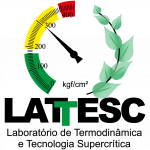History
EARLY YEARS (1992-1996)
With the return of Professor Haiko Hense after completing his master’s degree in Food Engineering at UNICAMP in 1990, and Professor José Vladimir de Oliveira, who completed his doctorate in Chemical Engineering at UFRJ in 1991, the Department of Chemical Engineering and Food Engineering (EQA) at UFSC initiated its first work orientations in the field of Thermodynamics. Initially, these efforts focused on theoretical works. However, the professors recognized the need for a dedicated space to conduct experiments. Professors João Borges Laurindo and Haiko Hense secured funding from a project submitted to the former FUNCITEC (Foundation of Science and Technology of Santa Catarina) to acquire a physical laboratory space.
In parallel, in 1992, Professor José Vladimir de Oliveira, with the participation of professors Ariovaldo Bolzan, Adelamar Ferreira Novaes, João Borges Laurindo, and Haiko Hense, successfully secured funding from the Fundação de Amparo à Pesquisa e Inovação do Estado de Santa Catarina to acquire the state’s first supercritical fluid (SFE) extraction unit. Consequently, the laboratory was named the Laboratory of Thermodynamics (LABTERM) and came under the supervision of Professors José Vladimir de Oliveira, Leonel Teixeira Pinto, and Ariovaldo Bolzan.
The following year, in 1993, the master’s program in Chemical Engineering was established at UFSC, and two master’s dissertations were carried out at LABTERM under the guidance of Professor José Vladimir de Oliveira. These dissertations were successfully completed in 1995. Additionally, in 1993, Professor Haiko Hense enrolled in the doctoral program in Process Engineering at the Technical University of Hamburg-Harburg (TUHH), Germany, temporarily shifting away from activities at UFSC. He returned to the institution in 1997. Furthermore, in 1996, Professor José Vladimir de Oliveira also temporarily withdrew from face-to-face activities at UFSC, resuming his involvement in 2011.
 UFSC’s first supercritical fluid extraction unit.
UFSC’s first supercritical fluid extraction unit.
RETURN AND RESTRUCTURING (1997-2010)
In 1997, upon Professor Haiko Hense’s return to UFSC after completing his doctorate, he assumed the role of supervisor for LABTERM. Around the same time, Professor Sandra Regina Salvador Ferreira, who was newly appointed to EQA in 1996, joined the laboratory, bringing her expertise in supercritical extraction. Consequently, the laboratory was renamed the Laboratory of Supercritical Extraction and Thermodynamics (LESTE). However, as this name had limited relevance, it was changed to the Laboratory of Thermodynamics and Supercritical Extraction (LATESC) in 1999.
In 2000, the master’s program in Food Engineering was initiated at UFSC. The majority of the laboratory’s dissertations were conducted through this program. However, the first two defenses under the name LATESC, in 1999 and 2000, by Luizilido Pitol Filho and Anne Jochmann, respectively, were still carried out under the Chemical Engineering program. It was not until the return of Professor José Vladimir de Oliveira to UFSC in 2011 that LATESC’s research in Chemical Engineering resumed.
Thanks to the strong connections established by Professor Haiko Hense during his doctoral studies, a collaborative project was initiated in 2000 between TUHH, UFSC, UNICAMP, and UFPA. Professors Gerd Brunner (TUHH) and Maria Angela Meireles (FEA/UNICAMP) spearheaded this project, which resulted in the development and construction of four identical supercritical fluid extraction units. These units were installed in each partner institution to ensure standardization across experiments.
In 2005, the doctoral program in Food Engineering was approved at UFSC, and the first LATESC theses were defended in 2009. Moreover, from 2006 to 2010, the laboratory received valuable support from Professor Julian Martínez, who also supervised research in the field of supercritical extraction.
 UFSC supercritical fluid extraction unit produced at TUHH.
UFSC supercritical fluid extraction unit produced at TUHH.
NEW EQUIPMENT (2011-2017)
Between 2010 and 2011, LATESC underwent further changes with the arrival of Professor Marcelo Lanza and the return of Professor José Vladimir de Oliveira to UFSC. In 2011, Professor Marcelo Lanza took over as the laboratory supervisor, succeeding Professor Haiko Hense. Around the same time, a partnership was established between UFSC and URI through Professor José Vladimir de Oliveira. This collaboration introduced new equipment and research areas to LATESC, focusing on phase equilibrium determination and high-pressure particle formation. As a result, the laboratory expanded its capabilities and acquired additional units, including pressurized medium reactors, pressurized liquid extraction (PLE) systems, and subcritical water equipment.
During this period, LATESC also experienced the retirement of Professor Haiko Hense in 2017. However, he continued to participate and provide guidance until 2019. Notably, these years witnessed a significant increase in the number of completed works at the laboratory. LATESC achieved its record for the highest number of works completed in a single year and maintained a consistent output of at least fifteen works per year, encompassing course conclusion projects, scientific initiation projects, master’s dissertations, doctoral theses, and postdoctoral projects.
In 2016, the laboratory underwent a final name change, becoming the Laboratory of Supercritical and Thermodynamic Technology (LATESC) to reflect the diverse research conducted with supercritical fluids.
 Particle formation unit in pressurized medium and phase equilibrium determination unit at high pressure.
Particle formation unit in pressurized medium and phase equilibrium determination unit at high pressure.
NEW PHYSICAL SPACE (2018-Today)
Towards the end of 2017 and the beginning of 2018, LATESC underwent a relocation process to the fourth floor of the EQA/UFSC laboratory building. The laboratory now occupies five rooms on this floor, sharing the space with the Analysis Center. This move provided LATESC with improved facilities and a dedicated area to carry out its research activities.
In addition to the relocation, 2018 marked the addition of a new faculty member to LATESC. Professor Acácio Antonio Ferreira Zielinski joined the laboratory as a newly appointed professor. His expertise and contributions further enhanced the research capabilities and academic endeavors of LATESC.
Professors Marcelo Lanza, Sandra Regina Salvador Ferreira, Acácio Antonio Ferreira Zielinski, Haiko Hense and José Vladimir de Olivieira at the inauguration of the new physical space.
Last update: 07/2022







